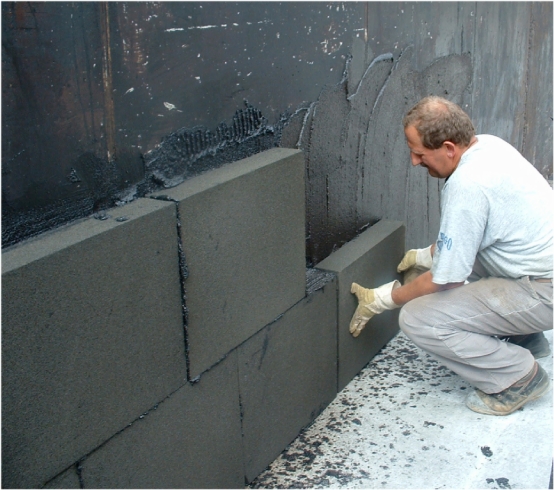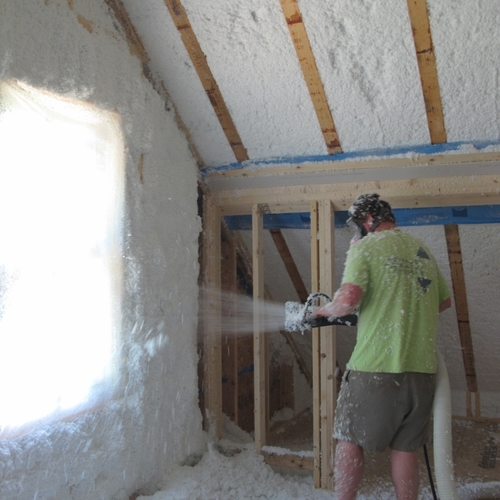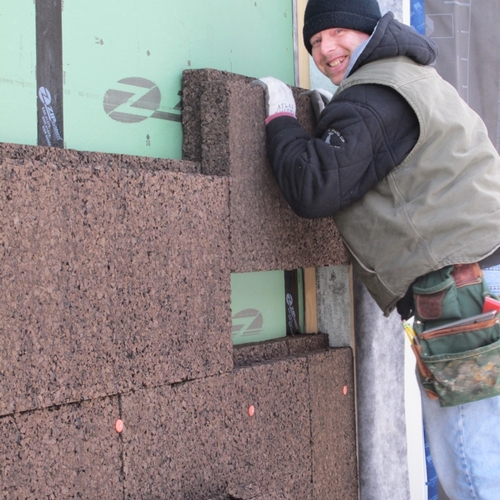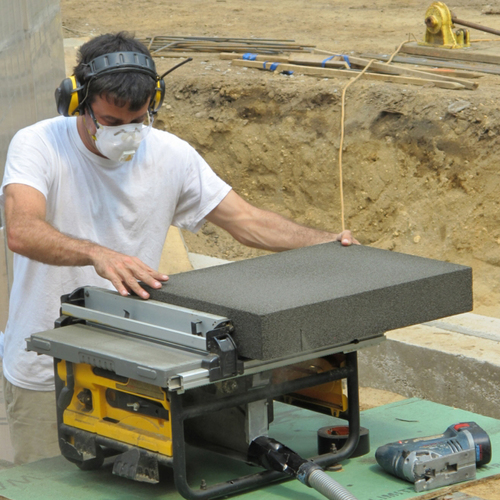Image Credit: Pittsburgh Corning Corp.
Image Credit: Pittsburgh Corning Corp. Foamglas is made in relatively small boardstock slabs (18 x 24") in thicknesses from 1-1/2" to 6".
Image Credit: Pittsburgh Corning Corp. The high compressive strength of Foamglas makes it ideal for sub-slab applications.
Image Credit: Pittsburgh Corning Corp. Asphalt sealant is used between Foamglas slabs to ensure a continuous seal.
Image Credit: Pittsburgh Corning Corp.
I spend a lot of time studying insulation–which is one of the most important components of any green home or commercial building. I have a new favorite. Foamglas¯ building insulation has been made by Pittsburgh Corning for many decades and is widely used in Europe. For the past decade or two, however, it has only been actively marketed in North America for industrial applications. (It’s been listed in our GreenSpec Directory as an industrial insulation material for years.)
Now Foamglas is back. Axel Rebel was brought over from Europe a couple years ago to rekindle interest in the product for building insulation. As Pittsburgh Corning’s vice president and general manager of the North American Building Division, he’s likely to make that happen. I met Rebel at the Building Science Corporation Westford Symposium (a.k.a. Summer Camp) last month, and I’ve been getting more excited about the product since then, as I’ve studied the particulars.
What is Foamglas?
Foamglas is a cellular glass insulation material that’s impervious to moisture, totally inert (no offgassing), resistant to insects and vermin, strong, and reasonably well-insulating (R-3.44 per inch). It can be used for insulating roofs, walls, and below-grade applications, including beneath slabs. It is produced in 18″ x 24″ dimensions, and in 1-1/2″ to 6″ thicknesses, in 1/2″ increments. An asphalt-based sealant is used between the insulation boards during installation.
Foamglas is 100% glass—manufactured primarily from sand, limestone, and soda ash. (Virgin ingredients are used in the two North American factories—in Texas and Missouri—while up to 66% recycled glass could be used, and European product has significant recycled content.) These ingredients are melted into molten glass, which is cooled and crushed into a fine powder. The powdered glass is poured into molds and heated (below the melting point) in a “sintering” process that causes the particles to adhere to one another. Next, a small amount of finely ground carbon-black is added, and the material is heated in a “cellulation” process. Here, the carbon reacts with oxygen, creating carbon dioxide, which forms the insulating bubbles in the Foamglas. CO2 accounts for more than 99% of the gas in the cellular spaces, and it is permanently trapped there.
If you scratch a piece of Foamglas (your fingernail can cut into it), you will detect a slight rotten-egg smell from hydrogen sulfide. Iron sulfate is used in the manufacturing process, and a small amount of hydrogen sulfide is produced. You don’t want to breathe a lot of hydrogen sulfide, but there’s very little in Foamglas and it’s locked tightly into the cellular glass—in fact, even after 30 years in place, scratching Foamglas produces the same smell. “It’s proof that the cells are absolutely airtight,” Rebel told me.
Features
I’m working on an in-depth product review for the October issue of Environmental Building News that will address the various performance properties and environmental attributes of Foamglas; I only touch on them here. Readers of my articles and blogs over the last few years know that I’ve been critical of certain insulation materials for the flame retardants, blowing agents, formaldehyde, and other chemicals contained in them. This is where Foamglas excels. There are no blowing agents that deplete ozone or contribute to global warming. There are no flame retardants or other additives needed to improve fire resistance.
As a 100% inorganic material, Foamglas is inert and fireproof. And it has enough compressive strength to be used under any concrete slab—an application where extruded polystyrene (XPS) currently dominates the market. It’s better than XPS, because, in addition to the absence of those chemicals, Foamglas is totally impervious to moisture (vapor and liquid), does not support mold growth, blocks radon, and keeps out termites and rodents.
Cost and availability
Foamglas is significantly more expensive than the other insulation materials we use. The typical cost of Foamglas T4+ (the most common product for building insulation) is about $1.00 per board-foot, according to Rebel—roughly two-and-a-half times the cost of extruded polystyrene (XPS), which averages about $0.40 per board-foot. Rebel admits that if you’re comparing insulation materials simply based on cost and insulation value, you’re not going to choose Foamglas. “We have to add another value,” he told me. That value can come from replacing other layers in the construction system (vapor retarders, moisture barriers, radon-control layers), from greater durability, from environmental attributes, and even from installing a thinner concrete slab. “We can reduce the thickness of the concrete slab, because Foamglas is so rigid,” Rebel said. Foamglas becomes more cost-competitive if you factor in all of these issues.
Foamglas is manufactured at two U.S. factories (in Texas and Missouri) and can be shipped anywhere. Product is currently distributed through dozens of dealers that primarily market industrial Foamglas materials. Rebel told me that it’s no problem to supply it for individual houses—though shipping may increase the cost and result in some delay. With Pittsburgh Corning looking to increase its presence in the building insulation market, and especially in green building, this could be a good time to try it out.
For more information, contact Pittsburgh Corning Corp. at 724-327-6100 or visit the company’s U.S. website.
In addition to this Energy Solutions blog, Alex writes the weekly blog on BuildingGreen.com: Alex’s Cool Product of the Week, which profiles an interesting new green building product each week. You can sign up to receive notices of these blogs by e-mail—enter your e-mail address in the upper right corner of any blog page.
Alex is founder of BuildingGreen, LLC and executive editor of Environmental Building News. To keep up with his latest articles and musings, you can sign up for his Twitter feed.
Weekly Newsletter
Get building science and energy efficiency advice, plus special offers, in your inbox.















24 Comments
Life Cycle Assessments
I would love to see GBA start requesting LCAs from manufacturers when you write about their products. Radical transparency is the future.
I look forward to the full
I look forward to the full product review but immediately some questions come to mind -
How is this product fastened to various substrates?
When used as insulation outboard a wall or roof deck how do you fasten through the Foamglas?
How are the seams dealt with to form a continuous thermal layer?
Can you cut this product on site?
vapour permeance
In the full product review, can you please provide the vapour permeance, coefficient of thermal expansion, and clarify if this product is combustible.
A few quick responses
For the standard T4+ Foamglas, water vapor permeability is 0.00 (ASTM E96). Product is noncombustible (ASTM E136). Coefficient of linear thermal expansion is 5.0 x 10-6/degree F or 0.000005/F (ASTM E228) or 9.0 x 10-4/degree K (EN13571). Compressive strength is 90 psi (greater compressive strength available with other Foamglas products).
Foamglas is usually glued to the substrate (various adhesives can be used). Metal fasteners can also penetrate the boardstock into the substrate below (such as a metal roof deck). Hot asphalt sealant is typically used between seams to provide a continuous barrier. With multiple layers (as used in Passive House construction), joints can be offset to keep thermal bridging to less than 1%. The material can be cut with a standard saw, though I haven't yet found out what type of blade is recommended. The material is fairly soft; you can score it with your fingernail.
Downside?
Alex,
I think someone at the Symposium mentioned a warning about this product.
A condition that might cause it to "crumble into powder".
Do you remember any negative comments or warnings?
Friability?
John,
The material is somewhat friable--leaving dust on your hands after handling, but I missed the mention at the Symposium about it crumbling into powder. I'll ask about that, but it would surprise me, given Foamglas's widespread use in industrial applications where vibration would seem common. I think of the "crumbling into dust" concern more with Air Krete--another interesting insulation material.
A different sealant needs to be developed
Speaking of this insulation in "Green" construction the use of asphalt for the seam sealant seems contradictory. Asphalt is made from petroleum. There needs to be a better sealing solution developed that doesn't use petroleum.
More on John's question on crumbling
John,
I checked with Foamglas about conditions that might cause the material to crumble. It is possible if it is used in an application where a) it can get wet, and b) where it is exposed to freeze-thaw. Such an application would be an "inverted" (IRMA) roof in which the insulation is installed on top of the roof membrane--a system that Dow Chemical developed and has promoted. Foamglas is not acceptable for this application.
Even though the boardstock is fully waterproof and impermeable, at the surface the glass cells are open. Those can fill with water and then freeze, breaking the surface cells and allowing moisture to penetrate down to the next layer of cells--and so forth. Eventually, the insulation would crumble, as you described. Pittsburgh Corning has long warned against the use of Foamglas in an inverted roof assembly.
Another question for Alex
Alex,
The photo appears to show Foamglass being installed on the exterior of a concrete foundation wall. If the Foamglas is extended to grade -- or, ideally, to the top of the concrete wall above grade -- it will inevitably be exposed to freeze / thaw cycles (unless, of course, it's being installed in the tropics).
It would also seem obvious that it's going to get wet -- unless you think there is a way to install it and then encapsulate it perfectly to keep it dry forever. So, is it going to crumble?
Foamglas on foundation walls extending to grade
Martin,
The material itself is fairly soft--you can dig into it with your fingernail--so for several reasons I think you would want to flash or otherwise protect the foamglas on an exterior foundation wall where it extends to grade. I wouldn't think the detailing would be too hard to adequately protect it.
Protecting above-grade insulation
Alex,
I understand the need for protection. But that doesn't stop the water from wicking into the insulation, nor does it stop freeze/thaw cycles. So let's say my FoamGlas is protected by a layer of stucco. Is the FoamGlas underneath the stucco getting more and more crumbly with every freeze/thaw cycle?
60 years of foamglass use
In the 1950's my father worked as a designer for a large chemical company. He designed their manufacturing facilities. When he built his house in the early 50's he used many industrial building components such as FoamGlass and Tectum and used industrial building methods; on-grade slabs, 12" cinder block walls, open steel trusses and poured concrete slab floors on all levels. 2" FoamGlass was used under the on-grade basement slab and on the outside of the undrground basement block walls. It was cut as needed on site with a large butcher knife. Cut off scraps made great sanding blocks for several years afterwards.
After nearly 60 years of West Virginia winters, with lots of freeze-thaw cycles each, there is absolutely no apparent deterioration of the Foamglass,
Can it be used on basement walls inside under drywall?
Can it be used on basement walls inside under drywall? What is the sound proofing properties? Is it safe inside?
FOAMGLAS Insulation Freeze-Thaw
Hello everyone, I am the Technical Manager for FOAMGLAS Building. I would like to make a few comments. FOAMGLAS insulation (FG) has been extremely successfully used as a building insulation for many years in Europe. FG is applied on roofs, interior and exterior walls, rainscreen and underground applications and is manufactured in block or board form. Although FG will not absorb moisture and water vapor will not penetrate FG, it is susceptible to freeze/thaw conditions when water sets in the outer surface cells and is trapped on the surface. Pittsbugh Corning warns about freeze-thaw in its literature. Many other insulations are also affected by freeze-thaw to some extent. If FG is properly applied and protected, freeze-thaw can be avoided. On underground vertical applications where FG is exposed to freeze-thaw conditions, the FG should be protected with a protection board or a thin mastic coating or some other method of protection. No protection is require below the freeze line. FG is a highly sustainable product and can last for decades. FG will not deteriorate under a stucco application. FG has been used in these types of applications for years. In rainscreen applications the FG is exposed to the environment, freeze-thaw is not an issue. I recommend Pittsburgh Corning's website http://www.foamglas.com to view the various applications where FG can be utilized. My comments may not have answered all of your questions but I hope you have a better understanding. FG has been around since 1937.
Howie Patrick
Other possible uses?
Has this product been considered as a core for SIPs? It seems like that might address some of the risks with standard foam cores and their production.
FOAMGLAS
I have a historic Victorian home. Heart Pine flooring with no sub-floor. Cold in the winter and hard to heat. Could this be installed under my floor.
Asphalt Sealant
I think MagicDave makes an excellent point about the asphalt sealant. I wouldn't want that in my house.
Foamglass as answer to thermal bridging as brick or stone ledge
The product has high compressive strength with zero creep. It is suitable for use as a 'first course' on a brick ledge. The Foamglass allows for continuous exterior insulation from the top of the footing to the roof. No more thermal break at this ledge. Install it with 'S' type or non shrink grout and then waterproof it with some good asphaltic based waterproofing.
We are currently building mockups for study and testing using Foamglass blocks as a sub straight for stucco applications. The Foamglass blocks would be placed as a veneer over a wood wall assembly, lathed and stucco placed.
This is a great product. Spend some time with it. The folks at PC are great to work with. Their literature is really instructive; even the ones written in German....the photos are worth a thousand words.
Sealant to prevent freeze-thaw problems?
If I understand correctly, the susceptibility to freeze/thaw damage of Foamglas is due to water ingress into the outermost, open, cells. Is it not possible to simply apply a sealant to fill these cells and prevent water getting in?
stucco over Foamglas?
George, have you completed your stucco over Foamglas mockups? If so, any feedback?
Foam glass retailers
I know this is years back, but where can I purchase Foamglas?
Stopped distribution
Last I checked (a year ago or so) they had stopped US residential distribution, and are only offering it in large quantities for industrial use. If the XPS industry is not crying wolf, and the HFC regulations actually increase the price of XPS, maybe that will be a good opening for Foamglas to re-enter the building market.
More on Foamglas leaving the residential market
Here is a link to a relevant GBA article: Foamglas Exits U.S. Residential Market.
I have seen several comments about the cost difference between FG and XPS. I would think the difference will, in part, be made up by several advantages of FG: it is FIREPROOF, it is ENVIRONMENTALLY BENIGN, it is much less compressible than XP, it is impervious to borrowing bugs and impervious to water vapor and air infiltration. There are also several coatings other than oil based tar that can be used to protect it from freeze/thaw issues (I expect a simple layer of 6 mil poly would do just fine in most applications). My next house will definitely have FG in all places where insulation is needed.
Log in or create an account to post a comment.
Sign up Log in